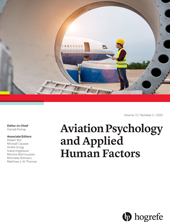Flying Solo
A Vignette-Based Examination of General Aviation Pilot Risk Perception and Decision-Making
Abstract
Abstract. The paper examines general aviation (GA) pilot risk perception and decision-making via an online vignette study. GA is a high-risk area of aviation with many GA accidents considered to be the result of pilot performance rather than mechanical failure. Pilots (n = 101) were presented with 12 go/no-go take-off decision scenarios across four risk categories (compromised performance, environment, faulty equipment, missing equipment). Scenarios depicting a missing checklist, missing sunglasses, and stress were considered less risky than illness, a faulty airspeed indicator (ASI), and a broken seatbelt. Pilots weighed their take-off decisions against mitigating factors, protective measures, and flight parameters. Situation awareness training and a focus on pre-flight planning may help to enhance flight safety within this group.
References
(2016). How to plan and perform a qualitative study using content analysis. NursingPlus Open, 2, 8–14. https://doi.org/10.1016/j.npls.2016.01.001
(2001). Today’s electronic checklists reduce likelihood of crew errors and help prevent mishaps. ICAO Journal, 56, 17–36.
(2013). The effects of emotion on pilot decision-making: A neuroergonomic approach to aviation safety. Transportation Research Part C: Emerging Technologies, 33, 272–281. https://doi.org/10.1016/j.trc.2012.04.005
. (2017). UK Aviation Safety Review for 2016 (CAP 1595). London, UK: CAA.
(1993). Cockpit checklists: Concepts, design, and use. Human Factors, 35(2), 345–359. https://doi.org/10.1177/001872089303500209
(2007). The limits of expertise: Rethinking pilot error and the causes of airline accidents. Surrey, UK: Ashgate Publishing.
(2000). Pilot situation awareness training in general aviation. Proceedings of the Human Factors and Ergonomics Society Annual Meeting, 44(11), 357–360. https://doi.org/10.1177/154193120004401107
. (2010). Sunglasses for pilots: Beyond the image (Publication No. AM-400–05/1). Oklahoma City, OK: FAA Civil Aerospace Medical Institute.
(2004). Qualitative content analysis in nursing research: Concepts, procedures and measures to achieve trustworthiness. Nurse Education Today, 24(2), 105–112. https://doi.org/10.1016/j.nedt.2003.10.001
(2006). How many interviews are enough? An experiment with data saturation and variability. Field Methods, 18(1), 59–82. https://doi.org/10.1177/1525822X05279903
(2000). On error management: Lessons from aviation. British Medical Journal, 320, 781–785. https://doi.org/10.1136/bmj.320.7237.781
(2002). Risk perception and risk tolerance in aircraft pilots (Report No. DOT/FAA/AM-02/17). Washington DC: Office of Aerospace Medicine Federal Aviation Administration.
(2006). Risk perception among general aviation pilots. The International Journal of Aviation Psychology, 16(2), 135–144. https://doi.org/10.1207/s15327108ijap1602_1
(2003). Understanding how pilots make weather-related decisions. The International Journal of Aviation Psychology, 13(1), 73–87. https://doi.org/10.1207/S15327108IJAP1301_5
(2018). Investigation of UK farmer go/no-go decisions in response to tractor-based risk scenarios. Journal of Agromedicine, 23(2), 154–165. https://doi.org/10.1080/1059924X.2017.1423000
(1996). Developing the personal minimums tool for managing risk during preflight go/no-go decisions (Report No. DOT/FAA/AM-96/19). Washington, DC: Office of Aerospace Medicine Federal Aviation Administration.
(1993).
A recognition-primed decision (RPD) model of rapid decision making . In G. A. KleinJ. OransuR. CalderwoodC. E. ZsambokEds., Decision making in action: Models and methods (pp. 138–147). New York, NY: Ablex Publishing Corporation.(2004). General aviation pilot takeoff into adverse weather: The “go/no-go” equation. Proceedings of the Human Factors and Ergonomics Society Annual Meeting, 48(3), 340–344. https://doi.org/10.1177/154193120404800314
(1993). Time pressure as a causal factor in aviation safety incidents – the ‘hurry-up’ syndrome. International Symposium on Aviation Psychology, 7, 269–274.
(2003). Continued VFR flight into IMC: Situational awareness or risky decision making. Washington, DC: Federal Aviation Administration Final Report.
(1994). Cognitive failure analysis for aircraft accident investigation. Ergonomics, 37(11), 1855–1869. https://doi.org/10.1080/00140139408964954
(2001). The role of risk in aviation decision-making: How pilots perceive and manage flight risks. Proceedings of the Human Factors and Ergonomics Society Annual Meeting, 45(2), 58–62. https://doi.org/10.1177/154193120104500213
(2002). Risk perception: A critical element of aviation safety. IFAC Proceedings Volumes, 35(1), 49–58. https://doi.org/10.3182/20020721-6-ES-1901.01639
(1998). Situation assessment for routine flight and decision making. International Journal of Cognitive Ergonomics, 1(4), 315–324.
(2019). How do general aviation pilots choose their route when flying in complex airspace? The International Journal of Aerospace Psychology, 29, 17–27. https://doi.org/10.1080/24721840.2019.1596744
(2018).
Planning of general aviation pilots using interviews . In N. StantonEd., International Conference on Applied Human Factors and Ergonomics (pp. 48–57). Cham, Switzerland: Springer. https://doi.org/10.1007/978-3-319-60441-1_5(2001). Naturalistic decision making in aviation environments (Report No. DSTO-GD-0279). Fishermans Bend, Australia: Defence Science and Technology Organisation Victoria (Australia) Aeronautical and Maritime Research Lab.
(1987). Perception of risk. Science, 236(4799), 280–285. https://doi.org/10.1126/science.3563507
(2004). Predictors of threat and error management: Identification of core nontechnical skills and implications for training systems design. The International Journal of Aviation Psychology, 14, 207–231. https://doi.org/10.1207/s15327108ijap1402_6
(1989).
Rational choice and the framing of decisions . In B. KarpakS. ZiontsEds., Multiple criteria decision making and risk analysis using microcomputers (Vol. 56, pp. 81–126). Berlin, Heidelberg: Springer.



